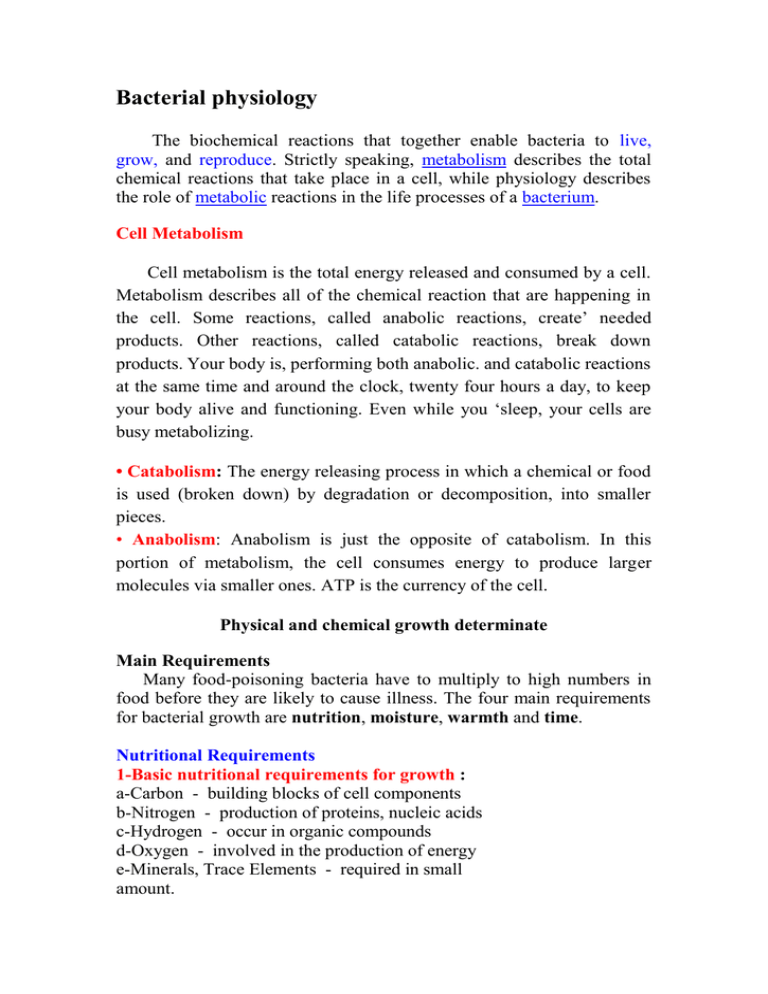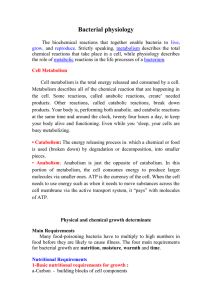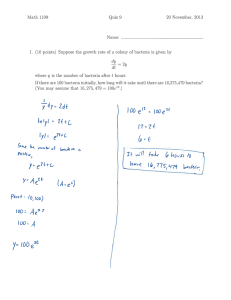Bacterial physiology
advertisement

Bacterial physiology The biochemical reactions that together enable bacteria to live, grow, and reproduce. Strictly speaking, metabolism describes the total chemical reactions that take place in a cell, while physiology describes the role of metabolic reactions in the life processes of a bacterium. Cell Metabolism Cell metabolism is the total energy released and consumed by a cell. Metabolism describes all of the chemical reaction that are happening in the cell. Some reactions, called anabolic reactions, create’ needed products. Other reactions, called catabolic reactions, break down products. Your body is, performing both anabolic. and catabolic reactions at the same time and around the clock, twenty four hours a day, to keep your body alive and functioning. Even while you ‘sleep, your cells are busy metabolizing. • Catabolism: The energy releasing process in which a chemical or food is used (broken down) by degradation or decomposition, into smaller pieces. • Anabolism: Anabolism is just the opposite of catabolism. In this portion of metabolism, the cell consumes energy to produce larger molecules via smaller ones. ATP is the currency of the cell. Physical and chemical growth determinate Main Requirements Many food-poisoning bacteria have to multiply to high numbers in food before they are likely to cause illness. The four main requirements for bacterial growth are nutrition, moisture, warmth and time. Nutritional Requirements 1-Basic nutritional requirements for growth : a-Carbon - building blocks of cell components b-Nitrogen - production of proteins, nucleic acids c-Hydrogen - occur in organic compounds d-Oxygen - involved in the production of energy e-Minerals, Trace Elements - required in small amount. 2-Special metabolites ( growth factors ) a-Substances required for growth that the cell cannot produce using the basic requirements already listed ( Ex. : vitamins, amino acids, carbohydrates, blood factors ) b- Organisms may be described as being fastidious Two types organisms based on source of nutrients : 1-Autotrophs - utilize inorganic compounds ( C - CO2, carbonates; N - NH4, N2, NO3 ) 2-Heterotrophs - utilize organic compounds ( C - CHO, lipids; N - proteins ) a- Saprophytes - nonliving organic material b- Parasites - viable (living) organic material Moisture Most foods naturally contain sufficient moisture to provide bacteria with the water they need in order to grow. Where moisture has been deliberately removed (e.g. in dehydrated foods such as milk powder, soup mixes, etc.), then bacteria will not grow whilst the food remains dry, but once water is added then bacterial growth may occur once more. Warmth / Temperature Bacteria have varying requirements in terms of the range of temperatures in which they will grow. Those which grow at low temperatures (usually below 20°C) are called psychrophiles and at high temperatures (above 45°C) are thermophiles. Most pathogens are known as mesophiles. They will grow at temperatures between 5°C and 63°C, commonly referred to as the growth or 'danger' zone and have an optimum temperature for growth of about 37°C. Time In ideal conditions (i.e. in moist foods at 37°C) bacteria will grow and multiply by dividing into two every 20 minutes. Other Factors Affecting Growth pH Level The acidity or alkalinity of foods will affect bacterial growth. Most bacteria like neutral conditions (pH value of 7) . Concentration of H+, OH- ions 1 ----------------------------------- 7 ------------------------------14 Acid Neutral Basic . Divided into four groups according to pH range : . *Neutrophiles - 5 to 8 *Alkalinophiles - 8 to 12 *Optimum pH 7.0 - 7.2 *Acidophiles - 0 to 5 Oxygen Pathogens vary in their oxygen requirements. Those which require oxygen are called aerobes, e.g. Bacillus cereus. Those which do not need oxygen are called anaerobes, e.g. Clostridium perfringens .Those which will grow or survive with or without oxygen are known as facultative anaerobes and include Salmonella species and Staphylococcus aureus. Microaerophilic - require the presence of small amounts of oxygen (2% 10%) . Osmotic pressure a- Exerted by solutes in water b- Increase o.p. outside cell - water leaves cell ( very high o.p. - dehydrates cell ) c- Decreased o.p. outside cell - water enters cell ( very low o.p. - lysis of cell ) d- Halophiles - require the presence of 3% NaCl ( extreme halophiles - 20 to 30% NaCl ) LIGHT ( RADIATION ) 1-Very small group photosynthetic bacteria (cyanobacteria) - require UV light 2- Nonphotosynthetic bacteria (eubacteria) - UV light is lethal (causes mutations) Competition Where there are a number of different bacteria present in food, they compete for the same nutrients. Pathogens are often not as competitive as spoilage bacteria and unless present in high numbers, will usually die.




